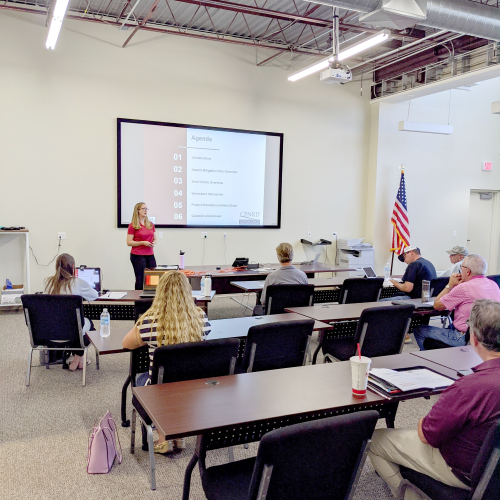JEO’s work on the Central Platte Natural Resources District (CPNRD) hazard mitigation plan (HMP) has been recognized with an implementation award from the Nebraska Chapter of the American Planning Association (APA). This award is a testament to the years of dedication put in by CPNRD and JEO to reduce flood risk and achieve measurable results. But how did this plan go beyond the present tangible impact—ensuring ongoing resilience of the community for years to come?
Supporting Flood Reduction Projects and Hazard Mitigation Funding
The CPNRD HMP reflects 10 years of effort, with updates every five years, including the most recent update in 2022. The plan outlines several goals:
- Protecting the health and safety of residents and properties from hazardous events
- Increasing public awareness about hazard events
- Promoting sustainability in the region
Through these updates, the plan has initiated many flood and other risk reduction projects to meet the goals and actions identified in the plan.
The plan has worked in tandem with existing projects, including the $24.5 million Upper Prairie-Silver-Moores Flood Risk Reduction project launched in 2004, addressing the need for improving flood and stormwater detention capacity outlined in the 2017 HMP update. This investment proved successful when, during the 2019 historic flooding throughout Nebraska, the City of Grand Island remained largely untouched. The project moved 600 properties out of the floodplain and prevented $90 million in damages during the event.
The CPNRD HMP also made local jurisdictions eligible for FEMA mitigation grants that directly funded various projects within the district, including multiple tornado sirens, a backup generator, weather radios, and a $7.7 million safe room. The safe room in Central City also serves as the school district’s new gymnasium and can hold up to 2,865 individuals.
Establishing Local Partnerships
Local voices provide vital insight during the hazard mitigation planning process to help assess risk, confirm that mitigation projects reflect the community’s needs, and ensure the plan works in concert with other existing planning documents. The CPNRD and county emergency managers made a meaningful effort to involve as many local jurisdictions as possible in the planning process, increasing participation from 30 different jurisdictions in 2012 to 54 in 2022.
Creating Lasting Community Awareness
To create lasting community awareness, the CPNRD partnered with local businesses, artists, and an ongoing music festival to present an interactive educational experience celebrating the City of Grand Island’s successful flood mitigation projects during the 2019 flood. The event, called the “Flood Control Stroll,” featured six stations that spotlighted flood mitigation trivia and offered resilience-themed food and drink specials.
Sparking Planning Momentum
Looking ahead, the plan has not only established and met long-term mitigation goals but has also been the catalyst for ongoing risk reduction efforts, including a drought management plan completed in 2020 and a flood risk assessment for areas of Grand Island most impacted by the 2019 flooding. The plan has also sparked the district's pursuit of three watershed and flood prevention operations plans.
Through ongoing updates and collaboration with local entities, the CPNRD HMP has proven to be dynamic and effective in driving risk reduction efforts. The CPNRD remains committed to its mission and will continue to utilize the award-winning HMP as a powerful tool to ensure the long-term resilience of the community.




